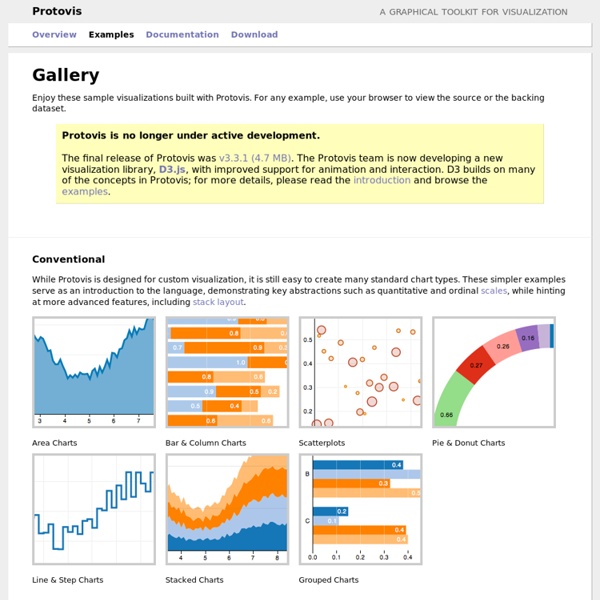City Of Melbourne : Pedestrian Counting System
Wednesday 22 March 2017 Trend over last 3 hours Note: If a sensor returns a series of zero readings it may be temporally inoperable
Protovis
Protovis composes custom views of data with simple marks such as bars and dots. Unlike low-level graphics libraries that quickly become tedious for visualization, Protovis defines marks through dynamic properties that encode data, allowing inheritance, scales and layouts to simplify construction. Protovis is free and open-source, provided under the BSD License. It uses JavaScript and SVG for web-native visualizations; no plugin required (though you will need a modern web browser)! Although programming experience is helpful, Protovis is mostly declarative and designed to be learned by example. Protovis is no longer under active development.The final release of Protovis was v3.3.1 (4.7 MB).
H&FJ News
Jason Kottke turned me on to this fantastic data visualization by Zach Beane, showing this year’s box office gross for American movies. Like this related graphic at The New York Times, it uses the x-axis for time and the height of each node to indicate revenue, but presents the data in a way that allows readers to infer four additional kinds of information — without having to complicate the graphic: The position on the y-axis represents each film’s rank, revealing the importance of a strong opening weekend (but begging the question of how The Bucket List, which opened in 23rd place, became the #1 movie in America the following week; something to do with New Year’s Day?) The slope of each line conveys the distinction between films with a slow burn (Juno) and those that flamed out (Cloverfield.)
Tools - Misleading axes on graphs
The purpose of a publication-stage data visualization is to tell a story. Subtle choices on the part of the author about how to represent a dataset graphically can have a substantial influence on the story that a visualization tells. Good visualization can bring out important aspects of data, but visualization can also be used to conceal or mislead. In this discussion, we'll look at some of the subtleties surrounding the seemingly straightforward issue of how to choose the range and scale for the axes of a graph. Bar chart axes should include zero
How-To: Get Started
Protovis uses JavaScript. It helps if you’re already familiar with the language, but it's not necessary; you can pick it up as you go, and learn by example. Here's a minimal but complete visualization that displays “Hello, world!”
Tools - Proportional Ink
In this article we explore a basic rule for the design of data graphics, the principle of proportional ink. The rule is very simple: when a shaded region is used to represent a numerical value, the area of that shaded region should be directly proportional to the corresponding value. In other words, the amount of ink used to indicate a value should be proportional to the value itself.
QGIS Labs
QGIS Tutorial Labs Home This is a set of tutorial labs for Quantum GIS, an open source geographic information system. The labs are based loosely on labs in my course ABT 180. They were developed with the help of the following students: Alex Mandel, Dylan Beaudette, Michele Tobias, Xuyang Zhang, Stacey Ellis, Heidi Schott, Michael Treichler, Melissa Whitaker, Kelly Gravuer, Michael Louie, Joel Bremson, Lauren Poremsky, Siqi Fajn, and Cherry Zamora.
The Joy of Stats
About the video Hans Rosling says there’s nothing boring about stats, and then goes on to prove it. A one-hour long documentary produced by Wingspan Productions and broadcast by BBC, 2010. A DVD is available to order from Wingspan Productions. Director & Producer; Dan Hillman, Executive Producer: Archie Baron. ©Wingspan Productions for BBC, 2010
Maps Web Services
We are shutting down this service. We suggest using maps from our partner Nokia. Please visit developer.here.net for more information. If you have any concerns or questions, please don't hesitate to contact us in General Discussion at YDN forum. International Maps
Sketchnotes: Tools and tactics for visual notetaking
About the presenter: Matt Miller has taught for more than a decade, integrating technology to engage students and create unique learning experiences. He created the Ditch That Textbook blog, is a Google Certified Teacher and co-hosts a podcast on the BAM Radio Network.



